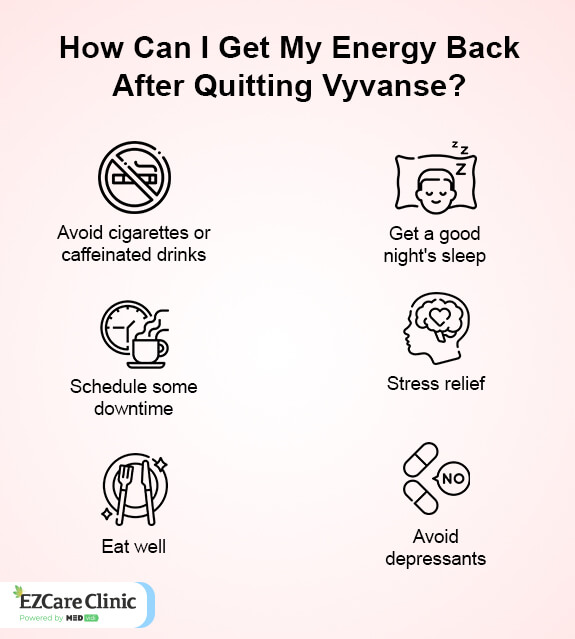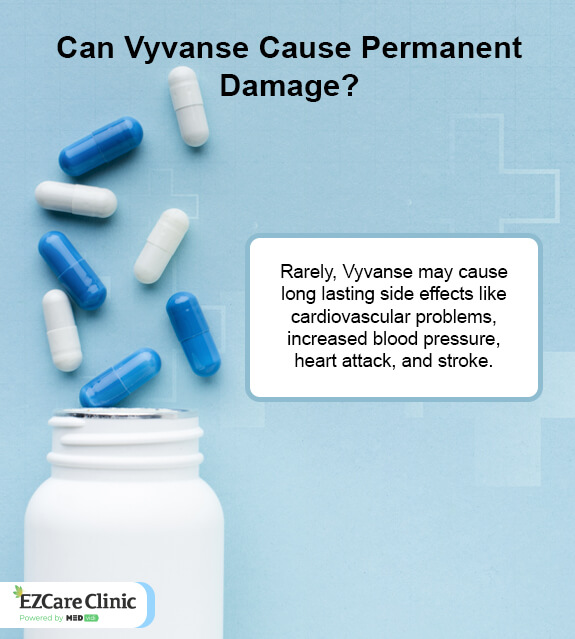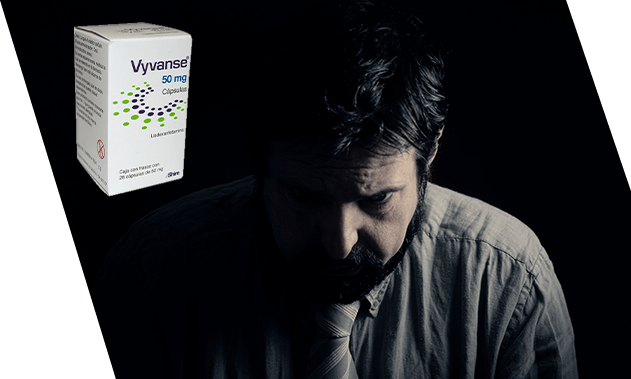The medications listed on this website are provided for informational purposes only. Their inclusion does not guarantee that they will be prescribed to any individual, as treatment decisions are ultimately at the discretion of healthcare providers. This list is not exhaustive, and healthcare providers may prescribe other medications, including non-stimulant options, based on the patient's unique health circumstances and needs.
Vyvanse is a brand name used to market the medicine Lisdexamfetamine. It belongs to the medicinal class of amphetamines and helps manage Attention Deficit Hyperactivity Disorder (ADHD), among other conditions. The medication falls under the Schedule II substance category in the United States. It is, therefore, a highly abused substance that often leads to physical and psychological dependence.
Mode of Action: The drug promotes the release of chemical substances (neurotransmitters dopamine & norepinephrine) from the principally stored areas. The chemical substances are critical in maintaining alertness and enhancing an individual’s attention. Furthermore, substances play a role in thought sustenance, effort, and motivation.
Let our licensed ADHD experts sort your mental health issues. Click on the banner below!

Vyvanse Withdrawal Symptoms
Typically, the medication serves as a
- Shaking
- Sweating
- Experiencing insomnia
- Irritability
- Depression
- Anxiety
The medical practice recommends gradual cessation of using the medicine to avoid the outlined withdrawal symptoms.

Vyvanse Withdrawal Timeline
Typically, there is a significant variation in how people tend to experience withdrawal symptoms when they cease using it. Some experience the symptoms, while others have slight indications of the symptoms. Often, the withdrawal symptoms disappear after a few days, but they occasionally last several weeks, particularly if someone has been using the medication for an extended period.
Immediately you stop using Vyvanse; you are likely to experience symptoms such as:
- Pains and aches
- Feeling the need to sleep
- A rise in appetite
- Mood swings
- Strong desire to resume using Vyvanse
- Strange thoughts
- General body weakness
The above symptoms will most likely disappear within a week. However, you may still experience the following symptoms in some cases, often termed post-acute Vyvanse withdrawal symptoms: anxiety, continued difficulty sleeping, and decreased energy levels, among others.
How Long Does Vyvanse Withdrawal Last?
It is important to note that the signs are likely to appear within a day or two following Vyvanse use cessation. They may, however, last for a couple of days though this is particular to individuals.Moreover, it is paramount to note that Vyvanse withdrawal symptoms duration is dependent on several factors. Often, coming off Vyvanse, withdrawal symptoms are determined by the duration of someone using the medication.
If someone has used the medication for an extended time, they may need more time before the symptoms disappear. Other factors that determine the duration that the symptoms last include;
- An individual’s genes
- The mental health and their health history
- An individual’s family addiction history
Book an appointment with our health experts at ezcareclinic to help overcome these symptoms.
Treatment and Prevention of Vyvanse Crash?
It is possible to control the withdrawal effects when someone prepares adequately before stopping using the medication. Sufficient preparation involves taking several steps when someone knows that they will cease using Vyvanse or when they intend to reduce their usage. Some of the essential steps include the following.
- Not taking any stimulants: This is a crucial step that involves refraining from using stimulants such as caffeine and cigars. They can also interfere with an individual’s sleep and elicit fatigue.
- Eating nutritiously: It is prominent to take foods rich in Vitamins, which enhance the moods, and take plenty of fluids, particularly water.
- Sleep sufficiently: It is vital to ensure good sleep by scheduling sufficient sleeping times and staying away from devices that interfere with sleep, such as smartphones.
- Do not take depressants: During this time, it is important to stay away from anything that depresses the nervous system, such as alcoholic drinks. Such depressants are responsible for interfering with an individual’s sleep and extending the comedown.
- Relieving stress: Another critical step is engaging in activities that decrease stress. Some worthwhile activities include meditation, walking, and listening to music that soothes the mind.
- Avoid multitasking: It is paramount to avoid schedules with too many activities since these may be pressuring, gradually leading to stress and anxiety.
Switching from Adderall to Vyvanse
Switching off from one drug to another can have some effects. As such, it is critical to change from Adderall to Vyvanse under the guideline of a medical professional. Switching off from Adderall to Vyvanse depends on factors such as the length and efficiency of Adderall on an individual’s system.
Medical professionals can recommend switching from Adderall to Vyvanse when diagnosing binge eating disorder since the latter can cure both ADHD and binge eating disorder. A more significant reason doctors recommend switching to Vyvanse is to lengthen the duration that the drug impacts an individual since Vyvanse stays longer in the system than Adderall does.
It is worth noting that people taking antidepressants should not take Vyvanse to avoid a rise in blood pressure. Moreover, when switching from Adderall, it is important to take a break of about two weeks before starting taking Vyvanse.

Medical Perspective
If you’re using Vyvanse or intend to switch from Adderall, it is critical to follow the guideline of medical experts. Medical professionals, ezcareclinic.com, specialize in various conditions, including depression, ADHD, and prescription medications of all ranges. Here, you’re sure to find an expert to diagnose every condition you or a friend may be suffering from.
Sources
- The effects of psychostimulant drugs on blood brain barrier function and neuroinflammation. (2012)
Source link



